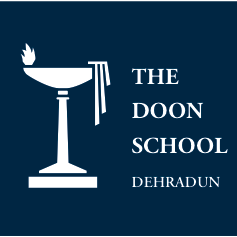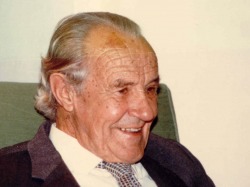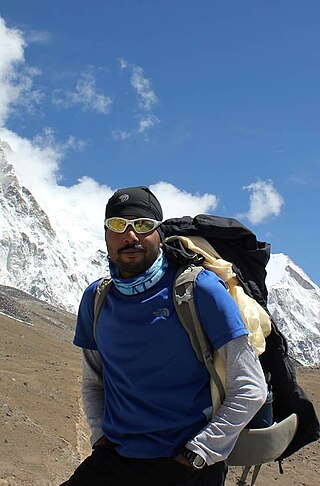The Himalayan Mountaineering Institute was established in Darjeeling, India on 4 November 1954 to encourage mountaineering as an organized sport in India.

The Doon School is a selective all-boys private boarding school in Dehradun, Uttarakhand, India, which was established in 1935. It was envisioned by Satish Ranjan Das, a lawyer from Calcutta, as a school modelled on the British public school while remaining conscious of Indian ambitions and desires. The school admitted its first pupils on 10 September 1935, and formally opened on 27 October 1935, with Lord Willingdon presiding over the ceremony. The school's first headmaster was Arthur E. Foot, an English educationalist who had spent nine years as a science master at Eton College, England.

Major Hari Pal Singh Ahluwalia was an Indian mountaineer, author, social worker and Indian Ordnance Factories Service (IOFS) officer. During his career he made contributions in the fields of adventure, sports, environment, disability and social work. He is one of six Indian men and the twenty first man in the world to climb Mount Everest. On 29 May 1965, 12 years to the day from the first ascent of Mount Everest, he made the summit with the fourth and final successful attempt of the 1965 Indian Everest Expedition along with H. C. S. Rawat and Phu Dorjee Sherpa. This was the first time three climbers stood on the summit together.

Captain Mohan Singh Kohli is an internationally renowned Indian mountaineer. An officer in the Indian Navy, who later joined the Indo-Tibetan Border Police, he led the 1965 Indian expedition which put nine men on the summit of Everest, a world record which lasted for 17 years.

Narendra Dhar Jayal (Nandu Jayal) (25 June 1927 – 28 April 1958) was an Indian mountaineer and an officer of the Bengal Sappers and the Indian Army Corps of Engineers. He is credited with pioneering and patronizing early post-Independence mountaineering in India, and was the founder principal of the Himalayan Mountaineering Institute. He encouraged the youth of India to take up mountaineering, and has been called the "Marco Polo of Indian Mountaineering".

Kalanag or Black Peak (6,387 m) is a peak in the Garhwal Himalaya in Uttarakhand, India. It is the highest peak in the Bandarpunch massif, others being Bandarpunch I (6,316 m) and White Peak or Bandarpunch II (6,102 m). The name literally means "Black Cobra" in Hindi.

Avatar Singh Cheema (1933–1989) was the first Indian man and the 16th person in world to climb Mount Everest. Along with 8 others he was a part of the third mission undertaken by the Indian Army, in 1965, to climb Mount Everest after two failed attempts. The Indian Everest Expedition 1965 put 9 mountaineers on the summit on 20 May, a record that lasted 17 years, and was led by Captain M S Kohli. Cheema's fellow summiters were Nawang Gombu, Sonam Gyatso, Sonam Wangyal, Chandra Prakash Vohra, Ang Kami, H. P. S. Ahluwalia, Harish Chandra Singh Rawat and Phu Dorjee. He was a captain in the 7th Battalion, The Parachute regiment at that time. Later he was promoted to colonel and commanded his battalion. He is also founder of Guru Harkrishan Public School in Sri Ganganagar District, Rajasthan.

John A. K. Martyn OBE (1903–1984), was an English schoolmaster, scholar, academic and a distinguished British Himalayan mountaineer. He was the second headmaster of The Doon School.

Gurdial Singh was an Indian schoolteacher and mountaineer who led the first mountaineering expedition of independent India to Trisul in 1951. In 1958, he led the team that made the first ascent of Mrigthuni . In 1965, he was a member of the first successful Indian expedition team to climb Mount Everest.

John Travers Mends Gibson was an English schoolmaster, scholar, academic and a distinguished British Himalayan mountaineer.
Colonel Narendra Kumar, PVSM, KC, AVSM, FRGS was an Indian soldier and mountaineer. He is known for his expeditions across various mountain ranges such as the Himalayas and Karakorams, and respective subranges such as the Pir Panjals and Saltoro Mountains. His reconnaissance efforts on the Siachen glacier were key to the Indian Army's reclamation of the forward posts of the glacier in Operation Meghdoot in 1984. He was the deputy leader of the first successful Indian Mount Everest expedition in 1965.

Sonam Wangyal is a former Indian paramilitary personnel and mountaineer who climbed Mount Everest in 1965 at the age 23, making him the youngest summiter. He was one of the nine summiters of the first successful Indian Everest Expeditions that climbed Mount Everest in May 1965 led by Captain M S Kohli,. He is the 3rd Indian man, and 18th man in world, to have climbed Mount Everest. On 22 May 1965, the first time that the oldest and the youngest climbed Everest together.

Sonam Gyatso (1923–1968) was an Indian mountaineer. He was the 2nd Indian man, the 17th man in world and first person from Sikkim to summit Mount Everest, the highest peak in the world. He was one of the nine summiters of the first successful Indian Everest Expeditions that climbed Mount Everest in May 1965 led by Captain M S Kohli. The first time that the oldest man at the time, Sonam Gyatso at age 42, and the youngest man Sonam Wangyal at age 23, climbed Everest together on 22 May 1965. He became the oldest person to scale the peak in 1965 and when he spent 50 minutes at the peak, he set a world record for spending the longest time at the highest point on Earth. The Government of India awarded him the third highest honour of the Padma Bhushan, in 1965, for his contributions to the sport of mountaineering.
The role of The Doon School in Indian mountaineering describes the formative links between The Doon School, an all-boys boarding school in Dehradun, India and early post-Independence Indian mountaineering. From the 1940s onwards, Doon's masters and students like A.E. Foot, R.L. Holdsworth, J.A.K. Martyn, Gurdial Singh, Jack Gibson, Aamir Ali, Hari Dang, Nandu Jayal, were among the first to go on major Himalayan expeditions in a newly independent nation. These early expeditions contributed towards laying the foundation of mountaineering in an independent India.

The 1965 Indian Everest Expedition reached the summit of Mount Everest on 20 May 1965. It was the first successful scaling of the mountain by an Indian climbing expedition.

Unnikannan is the first Keralite to successfully climb Mount Everest twice. He is a native of Azhuthan Poyil Veetil from Peringome, a village near to Payyannur in Kannur district of Kerala State, India

Colonel Ranveer Singh Jamwal, SM, VSM**, is an officer of the Indian Army and the first Indian to climb the Seven Summits along with Mount Everest three times. He is a veteran of more than 45 mountaineering expeditions. He presently holds two Asian records and three Indian Records in mountaineering.

Hari Dang (1935-2016) was an Indian educationist and a mountaineer. While at The Doon School, he led the schoolboys on the first Indian expedition to Mt. Jaonli in 1965.
Sonam Gyatso Mountaineering Institute (SGMI) is a paramilitary mountaineering school, located in Gangtok, India.














